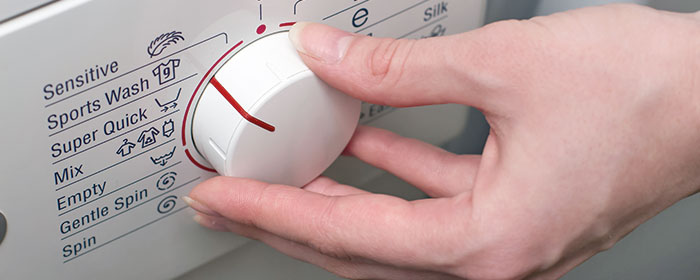Useful washing machine programmes
If you know what a mangle is, you may well appreciate the evolution of the washing machine. Even when the electric washing machine as first invented, there was only one programme – wash. As competition has grown, research and development has flourished and today we are able to do some remarkable things with our washing machines.

# Temperature washes
The single greatest improvement ever to washing machine technology was the installation of a thermostat. Different textiles require treatment and different temperatures (read our Washing Machine Temperature Guide). A learning curve that is quite common for new homemakers is that stains often become fixed when the item is washed in a hot wash. Hot washes are notorious for turning colours to a paler shade of what they once were. The importance of temperature to a wash, whether it a synthetic wash or a huge pile or naturals such as cotton or wool, the temperature of either or both the wash and rinse will have an influence on the outcome.
Naturals such as cotton can endure a wash of up to 90 degrees, but accidentally slip a woollen or natural hair jumper in with it and Dads big jumper will soon fit your daughter’s teddy bear. The key to a temperature controlled wash is to read the washing instructions on the labels of the items before you put them in the washer. Hot water can and does clean better, but it can also fix in a stain that a prewash treatment could help remove.
# Cotton wash
Most machines have a cotton wash setting and in fact it is usually at the top of the dial or list. Cotton is also probably the most washed textile. This textile does well and can tolerate hot temperatures. One thing to be wary of however is that a 30 degree wash on the cotton cycle will still turn out a very different result than the 30 degree wash on a synthetic cycle. This is because the machine will rinse and spin differently, even if the temperature is the same.
# Synthetic wash
While almost all machines will come with a cotton wash facility as standard, there are many that do not come with a synthetic was as standard. Some manufacturers treat synthetics as delicate and thus their delicates programme is designed to accommodate synthetic washes too.
# Woollens
Wool is one of the most difficult textiles to wash, without something going wrong, whether it is shrinkage or the garment stretching out of proportion. Woollens are typically washed with a slower drum rotation and in cooler temperatures. Some woollens are so sensitive that their care labels indicate that they should never be washed in a machine. Be sure to check this before putting them in. In machines where there is no synthetic setting, the woollens setting is the one that is most commonly used for other delicate materials and synthetics too.
# Sports wash
Sports programmes are the new kid on the block in terms of washing machine programme development. They are designed to deal with the very different textiles that are used in manufacturing sports and adventure clothing. Most the clothing needs to be, breathable but rugged enough for constant use. These items suffer huge exposure to sweat and body fluids, yet need to be washed in relatively low temperatures in order not to damage the materials that these items are made from. It really isn’t a disaster if your machine does not have one of these settings as you can still wash your sports clothing in a delicate or synthetics wash.
# Delicates
The Delicates program uses a gentle washing motion to prevent stretching, tearing, or fraying delicate fabrics like silk, lace, and satin. This gentle agitation ensures that the fabrics are cleaned thoroughly without causing any harm. In addition, the delicates program typically uses cold or warm (but not hot) water to prevent shrinking or damage. Some machines may allow you to adjust the temperature slightly based on the specific fabric care requirements.
# Mixed Load program
The Mixed Load washing machine program is designed to accommodate a variety of fabrics and colours in a single wash cycle. The Mixed Load program aims to strike a balance between effectively cleaning different types of fabrics while minimising the risk of damage. These settings may include variations in water temperature, agitation intensity, and spin speed to ensure optimal cleaning and care for different fabric types. Since the Mixed Load program allows for washing garments of different colours together, it often includes features to prevent colour bleeding and fading. This may include using cold water for the wash cycle and reducing the duration of the cycle to minimise the risk of colour transfer between garments.
# Quick wash cycles
To many homemakers the quick wash cycle is a gift from the gods. Being able to do a wash in around 25 minutes can often save the day if a piece of clothing is soiled on an important day. Some modern machines can do a quick was in as little as 15 minutes. You do need to remember however large loads of deeply soiled items will not wash well in a quick wash cycle and these cycles are not designed to take care of every day soiled loads.
# Rinse, Spin and drain
On some occasions washing processes need to be managed manually. Every modern machine will have a setting that permits a rinse, spin and drain cycle to run individually. These are very useful if the machine has had a problem with draining, and after an obstruction has been cleared you need to spin and drain the machine without having to complete a full cycle again.
# Self-Clean
The Self-Clean washing machine program is a feature found in some modern washing machines that allows the machine to clean itself, removing dirt, grime, and detergent residue that can accumulate over time. The Self-Clean program typically uses hot water to help dissolve and loosen any build-up inside the washing machine. Some Self-Clean programs may also use special cleaning agents or additives specifically designed to help dissolve and remove stubborn dirt and grime. These cleaning agents are usually added to the wash cycle along with the hot water to enhance the cleaning process.
Additionally, many washing machines offer customisable options such as temperature selection, spin speed adjustment, pre-soak, and extra rinse cycles to further tailor the wash to specific needs. It’s essential to consult your washing machine’s user manual for detailed instructions on each program and to ensure proper care of your clothes.
Many washing machine repair and service technicians will need to use these programmes to establish that different parts of the machine are working again after a repair. Whether it the repair has been made to the tub, the elements, the pump or any filters.
Get in touch with WM Repair Services
Whatever appliance you have and whatever age it happens to be, you now have easy access to a service you can count on. Our engineers provide repair solutions for all makes and models.
Call 020 3745 7452
Our advice and quotations are free. Whatever it is, just give us a call.
In addition to washing machines, we specialise in repairing a variety of home appliances. Our services include:



